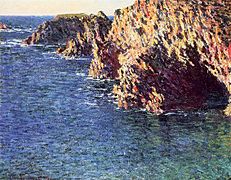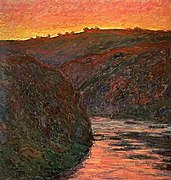Le Bloc
Le Bloc is a landscape painting by the French painter Claude Monet . The picture, painted in oil on canvas, measures 73 × 82 cm and shows the rocky top of a hill on the northern edge of the Massif Central . It is part of a series of 23 pictures that Monet painted in the spring of 1889 in the valley of the river Creuse and the surrounding area. The painting belongs to the British Royal Collection .
Image description
The painting Le Bloc (German: The Block ) shows the top of a rocky hill in close-up. The rock formation takes up almost the entire painting. At the top of the picture you can see a narrow strip of light blue sky with a few white clouds. In the upper left corner of the picture behind the rock, the branches of a treetop protrude into the sky. The branches are executed with gray-blue brushstrokes and a few color accents are set with white and pink. Contrary to what the title suggests, the rock is not a monolithic block. You can see small rock slopes, furrows or rubble. It is not always clear whether it is the surface of rock or whether it is partly a moss-like vegetation. Monet sketched the rugged surface with virtuoso brushstrokes in varied colors. The palette ranges from black, white and gray through pink, purple and red tones to ocher, yellow and green areas. Overall, the upper part of the hill is rather flatter, while it slopes steeply on the right edge.
In addition to the title Le Bloc, other names for the painting can be found in the literature . This is what Monet's biographer Gustave Geffroy noted alongside Le Bloc. Paysage de la Creuse ( The block. Landscape on the Creuse ) also the title Étude de Rochers (Creuse) ( Study of rocks (Creuse) ). In the English-language literature there is Study of rocks, Creuse ( study of rocks, Creuse ) or, more simply, The Rock ( the rock ). There are various explanations for the term study used in the French or English versions of the title. The detail of the picture was also unusual within Monet's previous work. The subject of the picture is not a landscape composition with the valley of the Creuse and the mountain slopes on both sides of the river - as Monet chose as a motif in other pictures on site - but the structure of the surface of a hilltop painted close up. The painting style with coarse brushstrokes chosen in many parts of the picture looks like an anticipation of Expressionism . Both the detail and the painting style had to appear to Monet's contemporaries like a preparatory sketch.
About the creation of the painting
In Claude Monet's landscape paintings, rock motifs appeared more and more, especially in the 1880s. In 1882 he painted pictures in Pourville-sur-Mer and 1883 Étretat with the rocky cliffs of Normandy . In 1884 he painted landscapes on the French Mediterranean coast in which mountains are repeatedly part of the compositions. In 1886 Monet stayed on the Breton coast and painted landscapes with motifs of the rock formations of Belle-Île . On this occasion he met the art critic Gustave Geffroy, with whom he befriended and who would become one of his later biographers. Three years later, in February 1889, the two of them traveled together to Fresslines on the northern edge of the Massif Central to visit the poet Maurice Rollinat , who lived there. Monet and Geffroy stayed a week and explored the area around Fresslines, where the Petite Creuse and Creuse rivers meet . Monet was enthusiastic about the impressive landscape with its gorges and rugged rock formations. After a short stay in his house in Giverny , he returned to Fresslines, equipped with his painting utensils. He rented a room in Madame Barronet's inn and stayed there for the next three months. In letters to his lover Alice Hoschedé , who looked after the children at home in Giverny, he wrote how much the weather affected him while painting, as it was very cold on the one hand and cloudy skies alternated with sunshine in rapid succession. The constantly changing lighting conditions weren't the only unpredictable factor. Monet also reported that the level of the Creuse was falling sharply, so that brown rocks and parts of the river bed became visible where masses of water had previously moved through the valley. The motifs, which were constantly changing by nature, inspired Monet to create a series of 23 paintings in which he depicted the valley of the Creuse. The painting Le Bloc was created when the temperatures were already a little warmer and Monet was able to climb one of the surrounding mountains with his easel. As early as June 1889, the art dealer Georges Petit exhibited 14 paintings by Monet with motifs from the Creuse in his gallery in Paris.
Provenance
Monet gave the painting Le Bloc to his friend, the politician Georges Clemenceau, in 1899 . After his death, his heirs sold it to the Parisian art dealer Wildenstein around 1931 . In 1945 Queen Elizabeth , the mother of the later Queen Elizabeth II , acquired Monet's painting for her private collection. The exact circumstances of the acquisition are not known. It is possible that the Queen was advised by the art historian Kenneth Clark , who directed both the National Gallery in London and the Royal Collection . After the Queen's death in 2002, the Monet painting became part of the Royal Collection.
literature
- Polly Cone: Monet's years at Giverny, beyond impressionism . Abrams, New York, 1979, ISBN 0-8109-1336-4 .
- Gustave Geffroy : Claude Monet, sa vie, son temps, son oeuvre . Crès, Paris 1922.
- Paul Hayes Tucker : Monet in the '90s, the series paintings . Museum of Fine Arts, Boston 1990, ISBN 0-300-04659-6 .
- Susanna de Vries-Evans: The lost impressionists, masterpieces from private collections . Rinehart, Niwot 1992, ISBN 1-879373-25-4 .
Individual evidence
- ↑ Le Bloc. Paysage de la Creuse on p. 189 and Étude de Rochers (Creuse) on p. 233 in Gustave Geffroy: Claude Monet, sa vie, son temps, son oeuvre .
- ↑ Study of rocks, Creuse in Susanna de Vries-Evans: The lost impressionists , p. 50; Study of Rocks, Creuse and The Rock in Paul Hayes Tucker: Monet in the '90s, the series paintings , p. 43.
- ^ Susanna de Vries-Evans: The lost impressionists , p. 50.
- ↑ Polly Cone: Monet's years at Giverny , p. 27.
- ↑ Information on the acquisition of the picture by Queen Elisabeth at www.royalcollection.org.uk
- ↑ Stephen Bates: Palace reveals details of Queen Mother's £ 50m will , article in The Guardian, May 18, 2002





